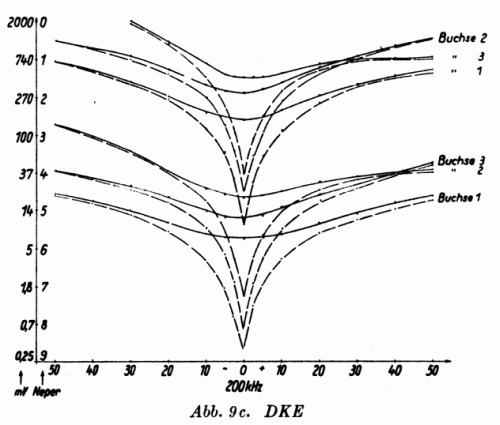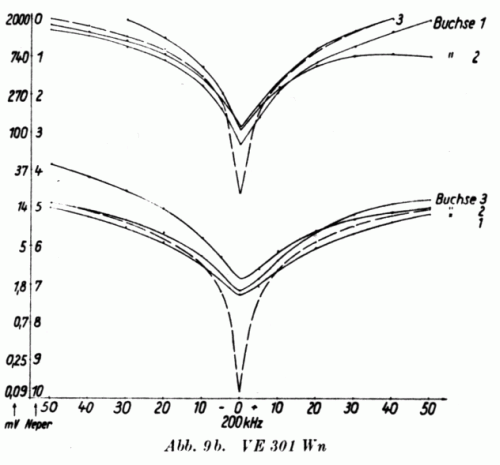WW2 Radio Broadcasting in Germany
WW2 Radio Broadcasting in Germany
Hope this is the proper place for my question. I have been told that one of the purposes of the WW2 Volks Emphanger was to prevent the German population from receiving propaganda broadcasts from other countries, by limiting its sensitivity and tuning range. Is this information correct? Also, was there any attempt within Germany during this period to confiscate or prevent the use of short wave receivers, for the same reason? Any information on the effect of WW2 on radio broadcasting in Germany and other affected countries would be of interest.
Thanks
.
To thank the Author because you find the post helpful or well done.
VE...myth and reality

The sensitivity myth will never die.... although technically not feasible.
There was an article some years ago in the BVWS Bulletin, dealing thoroughly with this and other myth's and aspects around the Volksempfaenger.
I now have asked the author, a friend of mine and RMorg member too, if he would give here a profound answer, as he did in a.m. article.
Let's cross fingers that he may find time to do so. In the meantime please be patient.
Kind regards,
KoBi
To thank the Author because you find the post helpful or well done.
Fascinating ? "Of interest" ? Really ?

seems that we cannot avoid such controversy, therefore at first some political and historical information for you : My parents and other elder relatives told me that it was always possible to receive radio stations from abroad. But this was forbidden, quite simply, at least during world war II. My grandfather was several times requested not to listen to such stations (e. g. BBC). I am not sure by whom, could have been a policeman or, more likely, the local party officer who was responsible for "political correctness" regarding mind and behaviour within a limited residential area. And I do not know what kind of radio my grandfather was operating, whether it was a "Volksempfänger" or older, earlier equipment.
Technical methodes, e. g. like working without RF-pre-amplifier or limited frequency ranges would only restrict the possibilty to receive stations from abroad but not prevent. I am sure that Mr Birkner's expert will give you the accurate technical response.
Kind regards
Rolf
To thank the Author because you find the post helpful or well done.
Short wave receiver

Yes, it is a myth that the Volksempfänger did not allow the reception of abroad radio transmitting. The purpose of the radio was to guarantee the reception of the next local radio station. Depending from antenna and location it was certainly possible to receive any abroad station like with any other 3 valve TRF receiver. The porpose was by offering a cheap receiver to get more households which have a radio. Industry had to reduce their margins. Compared to other European countries this was not very successful. The number of radio receivers per 1000 inhabitants was lower e.g. than in Denmark at that time. The purchasing power of the Germans was lower at that time. Nevertheles the propaganda and the myth lives till today.
The reception of abroad radio stations was forbidden and if the person talked about the received information to others he/she could even be punished by death penalty. (Several examples existing)
Concerning short wave receivers I have seen a book sevaral years ago which decribed the removal of the short wave coils from radio receivers without disturbing the other wave length.This was used by repairmen in the war only in by Germans occupied territories. So if you brought your receiver for repair to a shop it could be happen that the short wave range was removed. To my knowledge this was never done in Germany itself.
Rüdiger Walz
To thank the Author because you find the post helpful or well done.
Volksempfaenger Myth
The Volksempfaengers are excellent design examples of how to build a basic low-cost broadcast receiver, utilizing a minimum of critical materials. Even the cabinets (cases), which are of simple design, have an attractive functional appearance. I am fortunate to have a VE301-DYN and a VE301-W in my collection, and hope someday to restore them to operating condition.
Here in the U.S., the manufacture of consumer radio receivers was halted from approximately mid-1942 through 1945, with the exception of a few "morale" receivers for military folks. There was also a strict ban on amatuer radio transmissions during this time.
Regards,
To thank the Author because you find the post helpful or well done.
VE mythology

Certainly the biggest myth, as Konrad has rightly pointed out, is the sensitivity issue: and that they "...were deliberately designed so you could only hear propaganda broadcasts". This is quite untrue - as time passed by and the models were updated, their sensitivity got better, not worse. If you consider the period over which this occurred (1933-1939+) alongside the political history of the period, then surely if the myth was true the sets would have got worse, not better so as to ensure that only local transmitters were received? What does seem to get forgotten is this - the VE301 and its siblings were made, and sold, alongside conventional receivers which were more than capable of receiving broadcasts from around the world, and not instead of them. During the zenith of radio development in the late 1930s, German receivers were as much at the "cutting edge" of technical design as any radio from Britain or the US - my two favourite examples being the SABA 980WLK and the Körting "Transmare" models. In one model year 1,8 Million radio receivers were sold, of which 800.000 were the VE301 and variants. That means one million sets were not! I have heard English collectors in the past say that these radios were the sole product of the German radio industry during the Nazi era, as they only wanted you to hear their propaganda! This is, I am sure you will agree, utterly laughable.
The raison d'être of the "Volksempfänger" was to bring radio to as many people as it could, who hitherto could not afford a radio. Comparatively speaking, radio receivers were more expensive in Germany than elsewhere in the early-mid 1930s so a cheap receiver was needed to increase the number of the populace with radio. To ensure the maximum reach, in addition to the low price of the sets (RM65,- for the VE301Dyn, RM35,- for the DKE) there were also credit agreements which allowed the purchase of the sets on easy terms (typically a down-payment of RM5,- and fifteen monthly payments of RM2,- for a DKE), and for the seriously impoverished there was a method of means-testing which got you a radio for free.
Rüdiger has already mentioned that the sets were quite capable of receiving other transmissions and are probably no worse than any other set of their construction (a 0-V-1): the respected UK magazine "Wireless World" carried an article in the 2nd March 1939 edition describing the VE301Dyn and the DKE. The DKE was described as "surprisingly sensitive" in the article, but that it would need a wavetrap to separate out Droitwich from the Deutschlandsender (a common test for selectivity in contemporary "Wireless World" receiver reviews). The author then goes on to say that after the German stations closed down, Droitwich, which carried the BBC's "National" programme, and one medium wave station could be clearly received on a typical indoor aerial, as might be used by a flat-dweller in towns and cities. On longer aerials as would be usable in the countryside, naturally more could be received. The more expensive, and technically superior VE301Dyn was very much better in terms of sensitivity and selectivity.
In "Telegraphen-Fernsprech-Funk und Fernseh-Technik" of November 1938, sensitivity curves for the VE301Wn and the DKE were published. The VE301Wn is almost identical (from an RF point of view) to the 301Dyn, so the figures here can be used to judge how well a 301Dyn would perform. The curves for Long Wave (typically 150 - 350 kHz) reception are reproduced below:

The drawing above shows the sensitivity of the DKE on LW - the test frequency is 200kHz which coincidentally was the frequency of the Droitwich transmitter. Below is that for the VE301Wn:

So it can be seen that the sensitivity of the radios were not as bad as many are led to believe! Regrettably I do not have the full text to hand any more, just these image files so the reason for there being two sets of curves is open to clarification. For comparison, below is the sensitivity curve for the VE301W which should illustrate the improvement made between the 301W and the 301Wn:

Many accessories were also sold to improve both the usage and the performance of the sets - these ranged from a simple dial-lamp accessory to a superheterodyne converter (Körting VS1220), but most common were preselectors to improve general selectivity.
My personal experience of the radios is that they are much better than the myths lead you to believe: I am fortunate enough to have a DKE with a brand new VCL11 fitted, and it is amazing how many stations this little set can receive, and with quite good fidelity too - what does surprise many people is that if you study the circuit, you find that a degree of negative feedback exists around the output stage! Milt, I hope that you soon get to restore your VE301Dyn, as you will find it to be quite a surprise.
In summary, I would say - don't believe the many myths, because sometimes I feel it has become a case of "history being written by the victor". I could write more about the many other myths around these radios, but I feel that this is beyond the scope of the original question.
To thank the Author because you find the post helpful or well done.
VE Mythology
Many thanks for your very informative paper on VE history and performance characteristics. It definitely debunks a number of the myths commonly associated with the receiver. The information you provided will be a valuable addition to the RMorg archives.
I now really look forward to making my VE301's operational. It will be interesting to see how their performance compares with the test results you experienced.
Milt Margolis
To thank the Author because you find the post helpful or well done.
Hello,
During WW2 in Belgium and the Netherlands the use of radio receivers was forbidden exept those made by the Germans. Other models must be delivered to the German autorities. Before the war, people paid a lot of money for their radio's and many radio sets moved to hidden places. It was riskful to own or to listen to an illegal radio. A strange fact is that the Dutch magazine "Radio Bulletin" was still published during the war. Most people had no chance to listen shortwave. Only the more expensive radio's like the Philips 990x had a shortwave range that was good enough to be really used.
Kind regards,
Eduard
To thank the Author because you find the post helpful or well done.

Of the few countries that still manufactured civilian radios during WW II,
Germany was one of them, as evidenced in this Siemens 13W from my
collection( manufacturing date, 1942).
This radio has MW, Long Wave, and Short Wave and has directions on how to
operate in five languages, including English (try putting German or Japanese
on an Allied product from this period and see what would happen to you!).
The radio is pretty sensitive.
The United States, during WW II did not manufacture a single civilian radio!
From what I understand, the general population of the Axis controlled
portion of Europe were convinced that they were winning the war all the way
until the Battle of Stalingrad, when the war started to turn in favor for
the Allies.
I don't think that Berlin or Rome had a problem with broadcasts from London or Moscow before the end of 1943, since most of the population in the Axis controlled areas considered these broadcasts as "propaganda".
A perfect example of a view from this period is the 1943 movie starring the late Hans Albers, Münchhausen. A full feature Agfacolour film that shows a Germany that was quickly forgotten by 1945!
According to what I was told, it took many years after 1945 for Europe to realize the gravity of what happened in WW II.
- 13W3 (15 KB)
To thank the Author because you find the post helpful or well done.

I once had a DKE 38 and it was a good little radio for what it was. I'm sure it would have had no problem in receiving Droitwich, Allouis (before it fell) and others.
Attachments:
- Czech_warning (57 KB)
To thank the Author because you find the post helpful or well done.

The USA did not continue productionof civil radios, in accordance to the "War Planning Board Federal edict". For example Zenith converted totally to war production on April 22, 1942.
In Germany some production was maintained, mainly for export to gain foreign currency. A normal German citizen had hardly a chance to buy any radio. He needed an official purchase permit... and even then there was little chance to get one of the rationed items.
Export was the reason to accompany German WW2 radios with multilingual papers.
The USA had no export program for civil radios.
To thank the Author because you find the post helpful or well done.

As the war progressed domestic production declined and even stopped with many manufacturers but some manufacturers, e.g. Murphy, were able to release new models to the public, such a model being the A96 (see www.radiomuseum.org/r/murphy_a96_a_96.html) which was released in 1943, whilst others released small numbers of existing models onto the market (Bush sold some AC71s during 1944, I have a receipt for one).
Other manufacturers made sets for export during this period: Bush released their first export model (the EBS74H) at this time with some examples making their way onto the domestic market - I have a receipt for the sale of one near Manchester in 1942, and I also have a cabinet part from one. GEC were another company who made many models for export during the war, I have a rather woodworm-eaten example of such a set which is a 1943 model, it having the designation BC4342. Like the German situation, I would expect this was to get foreign currency into the British economy, a method that carried on long after the war ended.
To thank the Author because you find the post helpful or well done.